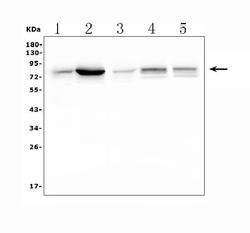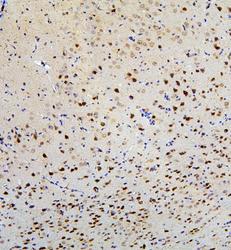A04372-2
antibody from Boster Biological Technology
Targeting: ACSL4
ACS4, FACL4, LACS4, MRX63, MRX68
Antibody data
- Antibody Data
- Antigen structure
- References [8]
- Comments [0]
- Validations
- Western blot [1]
Submit
Validation data
Reference
Comment
Report error
- Product number
- A04372-2 - Provider product page

- Provider
- Boster Biological Technology
- Product name
- Anti-FACL4/ACSL4 Antibody Picoband™
- Antibody type
- Polyclonal
- Description
- Rabbit IgG polyclonal antibody for FACL4/ACSL4 detection. Tested with WB, IHC-P, ICC/IF, FCM in Human;Mouse;Rat.
- Reactivity
- Human, Mouse, Rat
- Host
- Rabbit
- Vial size
- 100μg/vial
- Concentration
- Add 0.2ml of distilled water will yield a concentration of 500ug/ml.
- Storage
- At -20°C for one year. After reconstitution, at 4°C for one month. It can also be aliquoted and stored frozen at -20°C for a longer time. Avoid repeated freezing and thawing.
- Handling
- Add 0.2ml of distilled water will yield a concentration of 500ug/ml.
Submitted references Porphyromonas gingivalis as a promotor in the development of the alcoholic liver disease via ferroptosis.
Characterization of PKCα-rutin interactions and their application as a treatment strategy for pulmonary arterial hypertension by inhibiting ferroptosis.
Quercetin attenuates cerebral ischemic injury by inhibiting ferroptosis via Nrf2/HO-1 signaling pathway.
Paeoniae Radix Rubra extract attenuates cerebral ischemia injury by inhibiting ferroptosis and activating autophagy through the PI3K/Akt signalling pathway.
Inhibition of MALT1 reduces ferroptosis in rat hearts following ischemia/reperfusion via enhancing the Nrf2/SLC7A11 pathway.
Porphyromonas gingivalis is a risk factor for the development of nonalcoholic fatty liver disease via ferroptosis.
Scutellaria barbata Inhibits Hepatocellular Carcinoma Tumorigenicity by Inducing Ferroptosis of Hepatocellular Carcinoma Cells.
Old targets, new strategy: Apigenin-7-O-β-d-(-6″-p-coumaroyl)-glucopyranoside prevents endothelial ferroptosis and alleviates intestinal ischemia-reperfusion injury through HO-1 and MAO-B inhibition.
Yao C, Lu L, Lan D, Zhu X, Li X, Gao Y, Zhou Y, Wang Y, Xu Y, Qi S
Microbes and infection 2024 Mar-Apr;26(3):105250
Microbes and infection 2024 Mar-Apr;26(3):105250
Characterization of PKCα-rutin interactions and their application as a treatment strategy for pulmonary arterial hypertension by inhibiting ferroptosis.
Che H, Yi J, Zhao X, Yu H, Wang X, Zhang R, Li X, Fu J, Li Q
Food & function 2024 Jan 22;15(2):779-793
Food & function 2024 Jan 22;15(2):779-793
Quercetin attenuates cerebral ischemic injury by inhibiting ferroptosis via Nrf2/HO-1 signaling pathway.
Peng C, Ai Q, Zhao F, Li H, Sun Y, Tang K, Yang Y, Chen N, Liu F
European journal of pharmacology 2024 Jan 15;963:176264
European journal of pharmacology 2024 Jan 15;963:176264
Paeoniae Radix Rubra extract attenuates cerebral ischemia injury by inhibiting ferroptosis and activating autophagy through the PI3K/Akt signalling pathway.
Zhao F, Peng C, Li H, Chen H, Yang Y, Ai Q, Chen N, Liu F
Journal of ethnopharmacology 2023 Oct 28;315:116567
Journal of ethnopharmacology 2023 Oct 28;315:116567
Inhibition of MALT1 reduces ferroptosis in rat hearts following ischemia/reperfusion via enhancing the Nrf2/SLC7A11 pathway.
Jiang YQ, Yang XY, Duan DQ, Zhang YY, Li NS, Tang LJ, Peng J, Luo XJ
European journal of pharmacology 2023 Jul 5;950:175774
European journal of pharmacology 2023 Jul 5;950:175774
Porphyromonas gingivalis is a risk factor for the development of nonalcoholic fatty liver disease via ferroptosis.
Yao C, Lan D, Li X, Wang Y, Qi S, Liu Y
Microbes and infection 2023 Jan-Feb;25(1-2):105040
Microbes and infection 2023 Jan-Feb;25(1-2):105040
Scutellaria barbata Inhibits Hepatocellular Carcinoma Tumorigenicity by Inducing Ferroptosis of Hepatocellular Carcinoma Cells.
Li Y, Zhang J, Zhang K, Chen Y, Wang W, Chen H, Zou Z, Li Y, Dai M
Frontiers in oncology 2022;12:693395
Frontiers in oncology 2022;12:693395
Old targets, new strategy: Apigenin-7-O-β-d-(-6″-p-coumaroyl)-glucopyranoside prevents endothelial ferroptosis and alleviates intestinal ischemia-reperfusion injury through HO-1 and MAO-B inhibition.
Feng YD, Ye W, Tian W, Meng JR, Zhang M, Sun Y, Zhang HN, Wang SJ, Wu KH, Liu CX, Liu SY, Cao W, Li XQ
Free radical biology & medicine 2022 May 1;184:74-88
Free radical biology & medicine 2022 May 1;184:74-88
No comments: Submit comment
Supportive validation
- Submitted by
- Boster Biological Technology (provider)
- Main image

- Experimental details
- Western blot analysis of ACSL4 using anti-ACSL4 antibody (A04372-2). Electrophoresis was performed on a 5-20% SDS-PAGE gel at 70V (Stacking gel) / 90V (Resolving gel) for 2-3 hours. The sample well of each lane was loaded with 50ug of sample under reducing conditions. Lane 1: human placenta tissue lysatesLane 2: human HepG2 whole cell lysatesLane 3: human U2OS whole cell lysatesLane 4: rat brain tissue lysatesLane 5: mouse brain tissue lysates After Electrophoresis, proteins were transferred to a Nitrocellulose membrane at 150mA for 50-90 minutes. Blocked the membrane with 5% Non-fat Milk/ TBS for 1.5 hour at RT. The membrane was incubated with rabbit anti-ACSL4 antigen affinity purified polyclonal antibody (Catalog # A04372-2) at 0.25 μg/mL overnight at 4°C, then washed with TBS-0.1%Tween 3 times with 5 minutes each and probed with a goat anti-rabbit IgG-HRP secondary antibody at a dilution of 1:10000 for 1.5 hour at RT. The signal is developed using an Enhanced Chemiluminescent detection (ECL) kit (Catalog # EK1002) with Tanon 5200 system. A specific band was detected for ACSL4 at approximately 79KD. The expected band size for ACSL4 is at 79KD.
- Additional image

 Explore
Explore Validate
Validate Learn
Learn Western blot
Western blot Immunocytochemistry
Immunocytochemistry